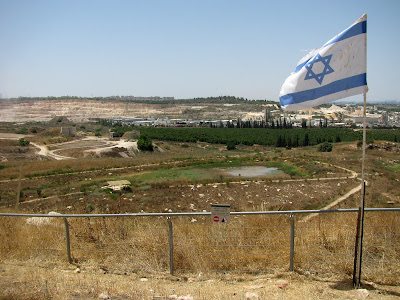The Migdal Tsedek fortress is located at the top of a hill, overlooking the "Afek Passage", part of the ancient Via Maris trade route. The Via Maris dates from the early Bronze Age and linked Egypt with the northern empires of Syria, Anatolia and Mesopotamia (modern day Iran, Iraq, Israel, Turkey and Syria). "Via Maris" means "Way of the Sea" in Latin. The historic route passed through Israel along the Israeli Mediterranean coast, and then onto the road to Jerusalem and Jericho, both important trade routes along the Mediterranean. Over time two fortresses were built on both sides of the Afek Passage. From one side there was the Yarkon National Park – Tel Afek (Antipatris), and from the other Migdal Tsedek (also known as Migdal Afek and, during the Crusader period, Mirabel, which means "beautiful view"). Migdal Tsedek means "Tower of Sadek" in Hebrew, referring to the name of its Sheikh, Muhammad al-Sadiq al-Jamma'ini.
In the Second Temple period a Jewish settlement called Migdal Afek was situated in the area of the national park. It was apparently destroyed by the Romans in the Great Revolt (one of three major Jewish rebellions against the Roman Empire). During the Crusader period a magnificent fortress was built on the hilltop. In the 12th century it was captured and destroyed by the Ayyubid army under the command of Saladin. Muslim sources in the 13th century describe the fortress as a village called Majdal Yaba. The village was one of the largest villages built along the line between the Samarian foothills and the coastal plain.
In the 17th century the village was renamed Majdal al-Sadiq after Sheikh Muhammad al-Sadiq al-Jamma'ini, the chief of the village who hailed from the prominent Rayyān family. They arrived from Transjordan and built a two-story manor house on the remains of the Crusader fortress. His rule was brief but his architectural influence can be seen to this day. The manor house contained some 60 rooms and courtyards. The ground floor was fronted by a large courtyard with space for animals and storage, and the top floor had four apartments in which the sheikh and his family lived.
By the 19th century the fortress, now known as the "Rayyān Fortress", was in ruins and the village ceased to be a centre of power.
By the 19th century the fortress, now known as the "Rayyān Fortress", was in ruins and the village ceased to be a centre of power.
During World War I, Majdal Yaba was the site of battles between the Axis troops, (forces of the Ottoman, German and Austro-Hungarian empires) and the British army. It was captured by British troops on the 9th of November 1917.
Between 1937 and 1947 there was a labour camp at Migdal Tsedek. Yitzhak Sadeh, who became the first commander of the Palmach (an elite fighting unit of the Haganah, the underground army of the Yishuv (Jewish community) during the period of the British Mandate for Palestine), established the force of Jewish policemen known as the Notrim at Migdal Tsedek. They worked under the British police force during the Arab Revolt, protecting Jewish settlements, factories and the roads.The activities of the Notrim allowed the stone industry at Migdal Tsedek to operate. The number of quarries in the area increased and the stone industry flourished. At its height some 35 lime kilns and stone quarries were in operation in the area and several attempts were made to establish a Jewish community where the quarry workers and their families would live a pioneering life.
However, when Israel's War of Independence broke out, the security situation worsened. It was decided to end Jewish labour in the Migdal Tsedek factories and withdraw the Haganah fighters. Iraqi forces took over the lime kilns and stone quarries.
On the 12th July 1948, Battalion 32 of the Alexandroni Brigade captured Migdal Tsedek in Operation Betek. The town of Rosh Ha'Ayin was established on village lands in 1949, and in 1953 Kibbutz Givat HaShlosha was moved to its current position, on the land of the newly deserted village of Majdal Yaba. When Holocaust survivors arrived in Israel, the kibbutz absorbed many young people.
In the 1970s the quarries, above and below, became neglected and were turned into rubbish dumps. Conservation and restoration work began at Migdal Tsedek in 1993. Original materials and ancient construction technologies were utilised as much as possible. The fortress's gatehouse and parts of the upper story were restored, along with the Crusader moat and a Crusader street. The entrances to the courtyards and the rooms once featured decorated lintels, most of which were stolen during the 1970s and 1980s. In 2014 the lintels were restored and reworked according to old photographs.
Migdal Tsedek National Park is still in the process of development. In the future, walking trails to the quarries and lime kilns, to the sheikh's tomb and to three winter pools that fill every year with rainwater from surface runoff are planned. The pools attracts various species of birds and animals including including the European green toad, Savigny's tree frog and the Levant water frog. Animals living in the park include striped hyenas, golden jackals, red foxes and gazelles. Migdal Tsedek is also on the migration route for millions of birds every year.
* This post has been shared on Little Things Thursday, Floral Passions, Blue Mondays, Wordless Wednesday (on Tuesday), Tuesday's Treasures and My Corner of the World.


















































20 comments:
Oh, that bird!
So much rugged beauty in your images.
What a neat place to explore!
Shana tova!!
It would be interesting to see what it once looked like - and was it in the wilderness or where they more cultivated lands? #FridayBliss
What a fascinating place, steeped in history. I love the photo of the bird - what type is it? Also, that free standing stone pillar looks a tad precarious! Glad you had a nice day out exploring. xx
Such fascinating place and interesting history & ruins. Finland is green compared to these views. It must be very hot & dry there.
What amazing history here. I can imagine the goods travelling back and forth. It is great to see there are plans to make the park more walkable. That is a handsome bird you captured there!
Before I am reading about your beautiful trip (as you know me, I read very detail:):)), thank you for giving me a comment at such a significant time - have a wonderful year of Jubilee! Hear that things have changed with this new president ... hard to judge when not living there, whether it's good or not so good/ But if the last is the case, I hope it will change again quickly, and not too much damage will be done, like here in the USA right now! Emille (Jesh)
What an interesting place to visit. I enjoy reading about your outings. I always learn something new. Fab pics too. x
Love your description of the park and all the history surrounding it. I had never heard of the Via Maris but it sounds fascinating. #MMBC
What a great place to visit. It sounds like there was plenty to see and a lot of history to learn about. How interesting. x
So much history and nature - another great adventure
Migdal Tsedek National Park looks like an interesting place to explore with an eventful history. Love the photos of the bird and the bee on the flower. #MMBC
What a fascinating country. A lifetime wouldn't suffice to appreciate its history.
Thanks for sharing this wonderful place with us at https://image-in-ing.blogspot.com/2021/09/going-buggy-in-our-yard.html
What a great place to explore. Beautiful views :)
I've said it before, and will probably say it again: The history that you explore and share here is just phenomenal. I've always been fascinated by the ancient trade routes. Standing there on the Via Maris would be so cool! Just think of the people and goods that have walked that path...and the stories behind them! Thanks, as always, for sharing.
Quite a bit of history! This is really interesting.
www.chezmireillefashiontravelmom.com
...the historical stories that this place can tell. Thanks for sharing some of them.
What a neat place to explore and I am just loving that bird photo! Thanks so much for sharing with us. Pinned.
What a fascinating place to explore - thanks for sharing with #PoCoLo
Such fabulous history in an area touched by God!
Thanks for sharing your link at My Corner of the World this week!
Post a Comment